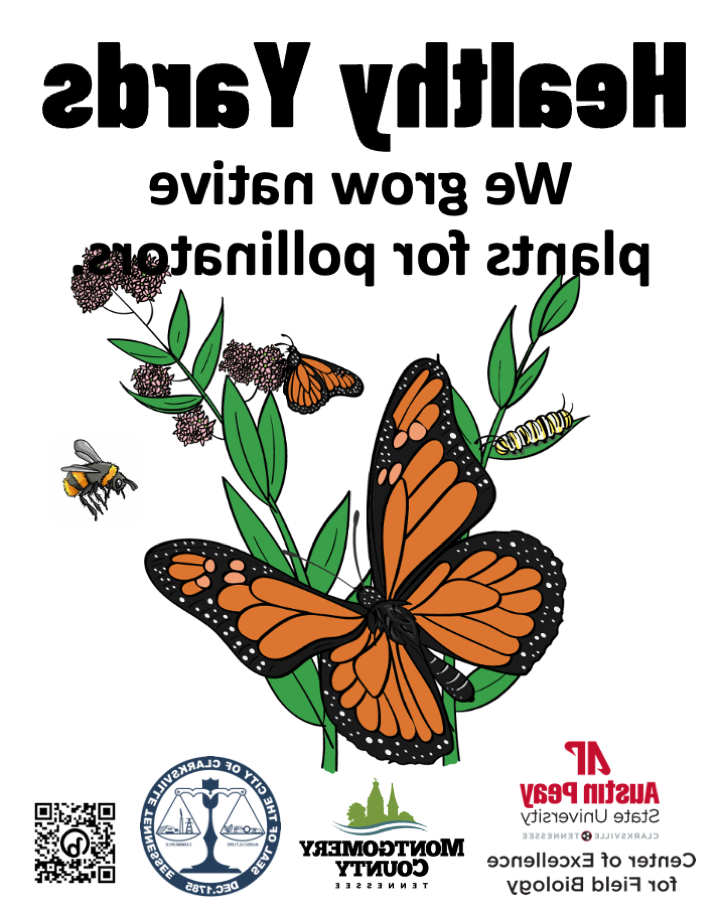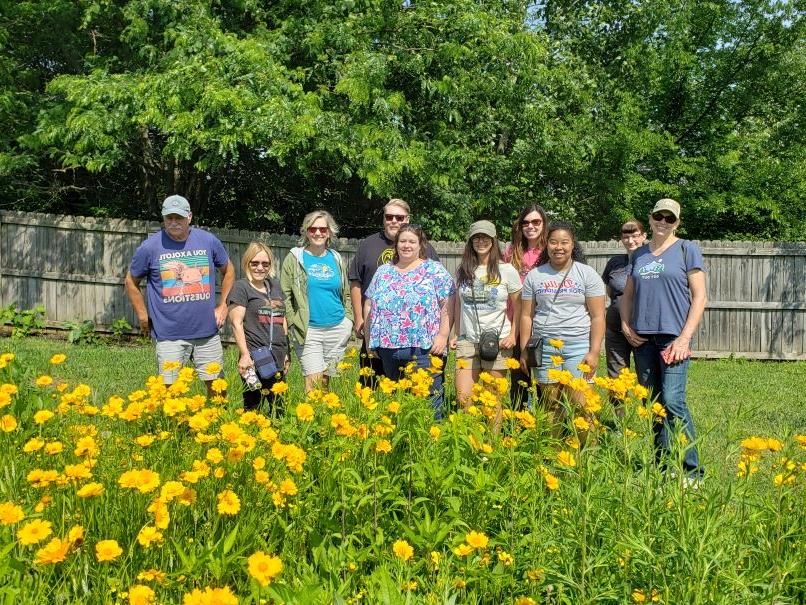Healthy Yards Clarksville-Montgomery County Program
We all rely on pollinating insects for the production of healthy fruits and vegetables and for healthy ecosystems that protect and benefit us in many ways. Healthy Yards aims to help residents provide a habitat for native pollinators. A yard with less lawn and more native plants can reduce the need for chemicals and watering and provide a healthier environment for children and pets. Healthy Yards is a program of the City of Clarksville's Sustainability Board and Montgomery County government with assistance from the 365bet Center of Excellence for Field Biology.

When you register your yard, you will receive an attractive and durable sign for your yard:
Healthy Yards - We grow native plants for pollinators
Register Your Yard
THIS SESSION OF THE CLASS IS FULL.
Gardening for Pollinators and Other Wildlife Class*
- $75 for 5-week series
- meets Thursdays, 5:30-7:00 PM, January 18-February 15, 2024
- sponsored by The 365bet Center for Field Biology’s Healthy Yards program
- open to everyone ages 15 and up
Join the growing movement of people who are passionate about planting for pollinators and take our 5-week course with 365bet’s Center of Excellence for Field Biology this January and February. If you are interested in cultivating a patch of garden focused on providing food and habitat for our very important pollinator and avian friends, this course is for you. Over the five weeks of class, we will explore how to plan a native pollinator garden and how to select the best plants based on your space, light, orientation, and the types of pollinators you want to attract. We will also cover simple garden design utilizing bloom time, height, and color along with where to purchase seeds and plants from reliable sources and why this is important. By the end of the course, you will have the information necessary to plan and plant a garden space with native plants that will be awash in color and a-buzz with bees and butterflies next season.
Your Instructor
Suzanne Adkisson, trained in the Master Gardener program, member of Healthy Yards 365bet Committee, experienced educator
*Course is not-for-credit and does not require university enrollment.
Contact us: ClarksvilleTNHealthyYards@gmail.com
How to Participate in Healthy Yards
- Commit to planting and maintaining three or more native plants that are host plants
for caterpillars or nectar sources for pollinators like native bees and butterflies.
- Choose plants that are native to our region, the southeastern U.S., have not been treated with pesticides, and are not decorative cultivars.
- Learn more below in the section about selecting and sourcing plants.
- Commit to avoiding the use of pesticides or herbicides.
- Chemicals can kill pollinators and the plants they rely on. They can be harmful to children and pets.
- Register online - Register Your Yard Here.
- You will receive an email when your yard sign is ready for pickup at the local United Way office.
- Proudly display your "Healthy Yards" sign to show your neighbors you are making a difference.
- Participate in Healthy Yards activities year-round.
- Events include plant and seed giveaways; native plant sales and free swaps; garden tours; winter sowing; garden planning seminars and more.
- Follow us on FB at http://www.facebook.com/HealthyYardsCMC
- Join the interactive group on FB at Clarksville TN Native Plants - gardening with plants native to Tennessee
Selecting and sourcing plants
Selecting a Location
- Most pollinator plants grow in full sun. Look for a location with 6-8 hours of sun per day. However, the late afternoon sun (when it is most hot) can be stressful on some plants that require more moisture.
- Group several plants of the same species for attractiveness, easier weeding and control of spread (if you choose to do so), and efficiency for pollinator feeding.
- Consider proximity to a water source, especially if you start from seed. Plants will need to be watered until they are established in the first few months, and small seedlings need more frequent watering.
Selecting Plants for a Native Pollinator Garden
- There is a gardening style for every personality. It’s fine to plan and execute a design, maintain specific plants only where intended, and exercise your managerial style. But it can also be very effective to try lots of plants, whatever you happen across, see what thrives, and let nature drive the process. Do you like an orderly garden design or prefer the look of a natural mixed-species meadow? It’s your choice.
- Native to where? For the benefit of pollinators and local ecosystems, the best choice is the most local. If you can get plants that are Tennessee natives, great! Most often, your best bet is a U.S. Southeastern regional native.
-
- Definitely avoid cultivars, plants that are selectively bred for different flower color or size or other traits that make them significantly different from their wild cousins. (You can recognize cultivars by the addition of a variety name, often, but not always, in single quotation marks like Baptisia australis ‘Sparkling Sapphires.’)
- Will you buy plants or seeds?
-
- Seeds can be a great bargain. In a good year, they will thrive with almost no care. (After all, how did nature do it?) But in periods without rain, seeds and seedlings need to be kept moist by watering.
-
- Purchasing plants can mean a much shorter period of supportive watering. Once established, plants that are well-chosen for the habitat will require little to no effort to thrive.
-
- Native seeds and seedlings are often shared in the local native plant community. Go to plant swaps and other events and don’t be afraid to ask. Most native gardeners love to share their bounty.
- Consider these factors when choosing plants
- Annual or perennial
- Height
- Sun requirements
- Soil moisture and watering needs (dry, moist, wet)
- Do you have deer resistance (less yummy)?
- Choose multiple species that will give you pollinator food and attractive blooms throughout the growing season. Pick plants that bloom in spring, others that bloom in summer and others for fall.
- Consider mature plant height and sun exposure. Place smaller plants in front so they will not be shaded by taller plants. In spacing plants, consider the eventual mature size of plants. It may take 2-4 years to reach maturity.
- Consider soil moisture. Select plants that prefer a dry, moist or wet environment – whatever best suits your location.
- Plant availability. Don’t fall in love with a plant until you find out if it is available from a reputable source or a native gardener friend.
Resource Links:
- Pollinator Partnership Garden Recipe Card Choose the Southeast garden plan. It’s designed for a 3’ x 6’ area but can easily be scaled up or down. It includes a critical design element: blooms from spring through summer and into fall. This provides a continuous food source for pollinators.
- Wild Ones Native Garden design for Chattanooga would work well for Clarksville, too.
- Native Plants for Pollinators and Beneficial Insects: Southeast Region from the Xerces Society for Invertebrate Conservation. Lots of helpful information in this list. Some species listed here may be somewhat difficult to source.
- Native Plants for Tennessee Smart Yards
- GroWild - Fairview, Tennessee
- In-person sales by appointment only
- Roundstone Native Seed
- Native seed, order online; located in Kentucky
- Native Wildflowers Nursery
- Order online and ship to your home; McMinnville, Tennessee
- Prairie Moon Nursery
- Order online, ship to your home; Winona, Minnesota
- Busy Bee Nursery and Consulting
- Plants sold at events in Bowling Green, Kentucky, and Glasgow, Kentucky. No shipping.
- Shannon Trimboli’s nursery - Kentucky
- Izel Native Plants
- Order online, ship to your home; a consolidation of wholesale suppliers
- Look up Tennessee to find plants native to here
- Annual 365bet Native Plant sale
- Online ordering in April, pickup on campus last weekend of April
- USDA Gardening for Pollinators
- Clarksville Montgomery County Beekeeping Association
- Montgomery County Master Gardeners
- Sierra Club Middle Tennessee
- Tennessee Noxious Weed list – plants to avoid or remove
- Visit a native pollinator garden on the 365bet campus

